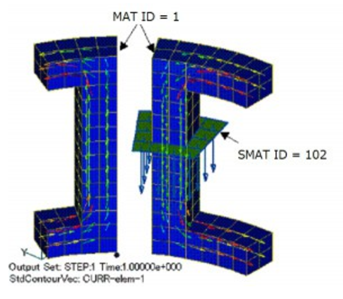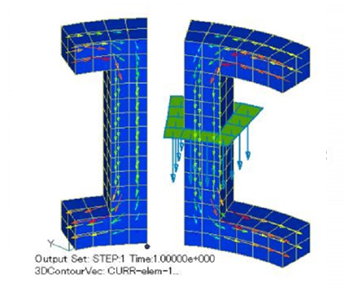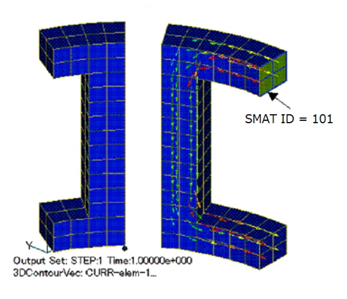PHICOIL at periodic boundaries
- TOP >
- Analysis Examples by Functions (List) >
- PHICOIL at periodic boundaries
Summary
PHICOIL (Potential Current Source), one of EMSolution’s current field sources, can be used simply by defining the current inflow surface on the conductor cross-section as a surface element, even if the coil has a complex shape. In "Static magnetic field analysis using PHICOIL" we also discussed the case where the current is cyclic. This section describes how to set up PHICOIL.
Explanation
Fig. 1 shows the case where only the coil is modeled with a symmetric periodic boundary (SYMMETRY =0) under the 60-degree rotational periodic boundary condition. The coils are assumed to be connected through the periodic boundary. In this case, define the current inflow plane, the PHICOIL definition plane, outside the periodic boundary plane as shown in Fig. 1. This surface is also used as a gap surface, so create a surface element one layer outward from the coil conductor. This can be easily understood by dividing the conductor into an inflow side and an outflow side by the gap surface and defining a PHICOIL between them to provide the current. The direction of the current is positive in the direction of the surface definition.
Fig. 1 shows the results of current distribution. Cyclic Symmetry boundary condition (one cycle of rotation results in the same direction) is used. The current is continuous across the PHICOIL definition plane. When the anti-symmetric periodic boundary condition (SYMMETRY=1) is used, one of the currents reverses (Fig. 2).
For reference, Fig. 3 also shows the case where 0 and 60 degrees are specular boundary conditions (Bn=0). As with the periodic boundary condition, an inflow surface can be defined on a surface other than the boundary surface, but it is easier to define it on the mirror symmetry boundary surface; there is no need to define a gap surface, only a PHICOIL definition surface. As can be seen from Fig. 3, no current flows in the coil on the left side where no PHICOIL is defined. This is because it is recognized as a separate coil in the case of specular symmetry, and it is necessary to define PHICOIL for that coil as well in order for current to flow. Note that PHICOIL cannot be defined on a surface with Ht=0. As with mirror symmetry boundary surfaces, it would be desirable to define PHICOIL at the boundary surface for periodic boundary surfaces as well, but this is not currently possible, and we apologize for the inconvenience. However, this is not currently supported, and we apologize for the inconvenience. The periodic boundary condition, the current inflow surface, and the gap surface condition overlap, so it is difficult to determine the boundary condition. Please be careful when using this function. This will be addressed in the future.
The rest of this page is for members only.
Analysis Examples by Functions
Current magnetic field source
- PHICOIL in rotational z-anti-mirroring symmetry
- Loop current defined by Potential Current Source (PHICOIL)
- PHICOIL at periodic boundaries
- SDEFCOIL and PHICOIL
- Steady-state DC+AC analysis of bulk conductors using PHICOIL and SUFCUR
- Heat generation output of current magnetic field sources
- DC current field analysis of bulk conductors
- Current Field Analysis on Periodic Boundaries
©2020 Science Solutions International Laboratory, Inc.
All Rights reserved.





